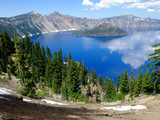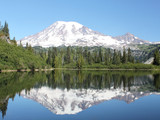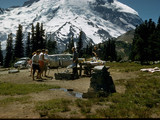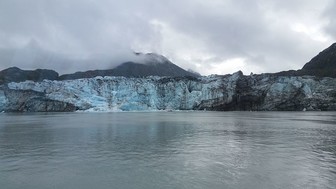Government Grants
Business Grants
Home Owner Programs
Federal Programs
About Us
Huna Tribal House Programs
Glacier Bay National Park (GLBA) is the ancestral homeland of the Huna Tlingit who sustained themselves on the abundant resources found throughout Glacier Bay prior to the Little Ice Age.
Although glacial advances overran villages inside the Bay in the 1700s, the Huna Tlingit re-established numerous
fish camps and several seasonal villages soon after glacial retreat.
Establishment of Glacier Bay National Monument, (and later National Park), led to a period of alienation and strained relationships between tribal people and the National Park Service (NPS).
In response to requests from the Hoonah Indian Association (HIA), the NPS began exploring options to construct a Tribal House on the shores of Bartlett Cove to memorialize ancestral villages and serve as an anchor for the Huna Tlingit in their homeland.
The Tribal House was first described in a 1997 Comprehensive Design Plan for Bartlett Cove.
An Environmental Assessment (EA) completed in 2013 with a `Finding of No Significant Impact,(FONSI Approved 3/28/2013), outlined plans for a 2,500 square foot main gathering area with an adjacent comfort station comprising restrooms and a small kitchen.
The building was designed to reflect the traditional plank house style, but to include modern amenities including electricity, heating, and information technology (IT) wiring.
It will serve as a venue for tribal members to reconnect with their traditional life-ways and ancestral knowledge; a focal point for educational programs designed to convey the story of the Huna Tlingit, traditional life-ways and values, and the evolving relationship of the Huna Tlingit and the National Park Service; and a site for appropriate National Park Service administrative activities.
Construction of the Tribal House commenced in spring 201 5. The Tribal House was completed in early summer 2016 and a Grand Opening Celebration occurred on August 25, 201 6. Through previous cooperative agreements, the NPS and HIA have begun several planning processes required to successfully operate the Huna Tribal House including a Strategic Plan, an Interpretive Plan, a Tribal Use Policy/Plan and annual operating/work plans.
These documents require considerable review and revision as we attempt to incorporate new information and input from multiple partners and disciplines.
While there are several similar facilities elsewhere in the National Park system that can serve as models, there are no NPS-owned facilities that are cooperatively managed by a tribal entity.
NPS and HIA are collaboratively developing policies and tailoring management approaches with little external guidance.
Additionally, to ensure that the newly opened Tribal House is relevant to park visitors, NPS and HIA must move forward with providing personal interpretive services during the visitor use season and must develop a number of interpretive products outlined in the Interpretive Plan.
Importantly, NPS and HIA have both prioritized tribal use of the Tribal House, particularly in this inaugural year, both to ensure cultural relevance and to encourage tribal connections to the new building.
Two totem poles carved under a previous cooperative agreement were installed in front of the Tribal House in a totem pole raising ceremony for both totems on May 20, 201 7. The Healing Totem Pole was raised on August 25, 201 8. The primary purpose of this cooperative agreement is to provide a framework for:
1) restoring trust with local communities by building and strengthening communication and relationships with the Huna Tlingit tribal community, 2) enhancing relationships with the Hoonah Indian Association, a sovereign nation, and 3) creating jobs for our neighbors and partners, the Huna Tlingit.
The project focuses on ongoing collaborative planning and operation of the Huna Tribal House including, but not limited to:
1) finalizing a Strategic and Operational Plan for the Tribal House that formalizes the partnership between the NPS and the Hoonah Indian Association, 2) cooperatively producing a series of interpretive products (including two feature length films and a series of wayside exhibits), and providing interpretive services at the Tribal House, 3) planning and implementing an annual Celebration at the Huna Tribal House, and 4) other cultural programs association with, or in support of, the Huna Tribal House.
Although glacial advances overran villages inside the Bay in the 1700s, the Huna Tlingit re-established numerous
fish camps and several seasonal villages soon after glacial retreat.
Establishment of Glacier Bay National Monument, (and later National Park), led to a period of alienation and strained relationships between tribal people and the National Park Service (NPS).
In response to requests from the Hoonah Indian Association (HIA), the NPS began exploring options to construct a Tribal House on the shores of Bartlett Cove to memorialize ancestral villages and serve as an anchor for the Huna Tlingit in their homeland.
The Tribal House was first described in a 1997 Comprehensive Design Plan for Bartlett Cove.
An Environmental Assessment (EA) completed in 2013 with a `Finding of No Significant Impact,(FONSI Approved 3/28/2013), outlined plans for a 2,500 square foot main gathering area with an adjacent comfort station comprising restrooms and a small kitchen.
The building was designed to reflect the traditional plank house style, but to include modern amenities including electricity, heating, and information technology (IT) wiring.
It will serve as a venue for tribal members to reconnect with their traditional life-ways and ancestral knowledge; a focal point for educational programs designed to convey the story of the Huna Tlingit, traditional life-ways and values, and the evolving relationship of the Huna Tlingit and the National Park Service; and a site for appropriate National Park Service administrative activities.
Construction of the Tribal House commenced in spring 201 5. The Tribal House was completed in early summer 2016 and a Grand Opening Celebration occurred on August 25, 201 6. Through previous cooperative agreements, the NPS and HIA have begun several planning processes required to successfully operate the Huna Tribal House including a Strategic Plan, an Interpretive Plan, a Tribal Use Policy/Plan and annual operating/work plans.
These documents require considerable review and revision as we attempt to incorporate new information and input from multiple partners and disciplines.
While there are several similar facilities elsewhere in the National Park system that can serve as models, there are no NPS-owned facilities that are cooperatively managed by a tribal entity.
NPS and HIA are collaboratively developing policies and tailoring management approaches with little external guidance.
Additionally, to ensure that the newly opened Tribal House is relevant to park visitors, NPS and HIA must move forward with providing personal interpretive services during the visitor use season and must develop a number of interpretive products outlined in the Interpretive Plan.
Importantly, NPS and HIA have both prioritized tribal use of the Tribal House, particularly in this inaugural year, both to ensure cultural relevance and to encourage tribal connections to the new building.
Two totem poles carved under a previous cooperative agreement were installed in front of the Tribal House in a totem pole raising ceremony for both totems on May 20, 201 7. The Healing Totem Pole was raised on August 25, 201 8. The primary purpose of this cooperative agreement is to provide a framework for:
1) restoring trust with local communities by building and strengthening communication and relationships with the Huna Tlingit tribal community, 2) enhancing relationships with the Hoonah Indian Association, a sovereign nation, and 3) creating jobs for our neighbors and partners, the Huna Tlingit.
The project focuses on ongoing collaborative planning and operation of the Huna Tribal House including, but not limited to:
1) finalizing a Strategic and Operational Plan for the Tribal House that formalizes the partnership between the NPS and the Hoonah Indian Association, 2) cooperatively producing a series of interpretive products (including two feature length films and a series of wayside exhibits), and providing interpretive services at the Tribal House, 3) planning and implementing an annual Celebration at the Huna Tribal House, and 4) other cultural programs association with, or in support of, the Huna Tribal House.
Who's Eligible
Relevant Nonprofit Program Categories
Obtain Full Opportunity Text:
http://www.grants.gov
Additional Information of Eligibility:
U. S. non-profit/non-governmental organizations (NGOs) having a 501(c)(3) status with the IRS or non U.S.-based NGOs, U. S. and non U.S.-based public and private institutions of higher education.
A consortium of non-profits can apply together as long as there is one lead organization submitting the proposal, and public international organizations.
Full Opportunity Web Address:
http://www.grants.gov
Contact:
Agency Email Description:
Work
Agency Email:
Date Posted:
2020-04-06
Application Due Date:
Archive Date:
2020-04-13
Social Entrepreneurship
Spotlight
Calgary Social Enterprise Offers High-Tech Services by People with Autism

Meticulon, a project of Autism Calgary Association in partnership with the federal government and the Sinneave Family Foundation, operates as a social enterprise that renders high-tech services provided by people with autism, leveraging their natural abilities at requiring attention to detail, repetition, and sequencing.





